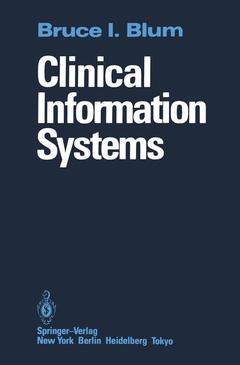Description
Clinical Information Systems, Softcover reprint of the original 1st ed. 1986
Author: Blum Bruce I.
Language: English
Subject for Clinical Information Systems:
Approximative price 105.49 €
In Print (Delivery period: 15 days).
Add to cart
Publication date: 02-2012
414 p. · 15.5x23.5 cm · Paperback
414 p. · 15.5x23.5 cm · Paperback
Description
/li>Contents
/li>
As its name implies, this book deals with clinical information systems. The clinical information system (or CIS) is an automated system with a long term database containing clinical information used for patient care. This definition excludes business systems (no clinical data), physiological monitoring systems (no long term database), and many research systems (not used in patient care). The theses of this book are (a) that CIS technology is mature, (b) that the CIS will have a major impact upon patient care and the health delivery system, and (c) that the number of commercial systems which now offer these potential benefits is very small. The objective of this book is to establish the above theses and thereby (a) inform both users and developers, (b) increase the demand for more sophisticated products, and finally, (c) provide marketplace incentives to advance the state of the art. The CIS is an application of computer technology for a specific class of problems. Its development requires a knowledge of the technology with an understanding of the application area. As with any tool-based application, the scope of the product will be limited by the capability of the tool. In the case of the CIS, reliable computers with comprehensive database facilities became com mercially available in the early 1970s. By the mid 1970s there was a maturation of the literature, and evaluations of 5-years' use began to appear. As will be shown, there have been surprisingly few new ideas introduced since the 1970s.
I. Background and Introduction.- 1. History of Computers.- 1.1. Introduction.- 1.2. The Early Foundations.- 1.3. Early Electronic Computers.- 1.4. The Modern Computer.- 1.5. Concluding Remarks.- 2. Computers and Health Care.- 2.1. Historical Overview.- 2.2. Data Oriented Applications.- 2.3. Information Oriented Applications.- 2.4. Knowledge Oriented Applications.- 2.5. Concluding Remarks.- II. Computer Systems.- 3. Overview of Hardware and Software.- 3.1. Introduction.- 3.2. The Personal Computer.- 3.3. The Multiuser Environment.- 3.4. Networking Computers.- 3.5. Concluding Remarks.- 4. Programming Languages.- 4.1. Introduction.- 4.2. Survey of Programming Languages.- 4.3. Some Programming Languages.- 4.4. Concluding Remarks.- 5. Data Bases.- 5.1. Introduction.- 5.2. File Structures.- 5.3. Data Base Management Systems.- 5.4. Database Design.- 5.5. Concluding Remarks.- 6. System Implementation.- 6.1. Introduction.- 6.2. System Level Activities.- 6.3. Application Software Development.- 6.4. Programming Heuristics.- 6.5. Concluding Remarks.- III. Clinical Applications.- 7. Hospital Information Systems.- 7.1. Introduction.- 7.2. Information Processing.- 7.3. Some Hospital Information Systems.- 7.4. Evaluation.- 7.5. Concluding Remarks.- 8. Ambulatory Care Systems.- 8.1. Introduction.- 8.2. Automated Ambulatory Medical Record.- Systems.- 8.3. Some Ambulatory Care Systems.- 8.4. Evaluation.- 8.5. Concluding Remarks.- 9. Medical Decision Making.- 9.1. Introduction.- 9.2. Medical Decision Making.- 9.3. Strongly Formalized Techniques.- 9.4. Artificial Intelligence in Medicine.- 9.5. Concluding Remarks.- 10. A Case Study.- 10.1. Introduction.- 10.2. The Johns Hopkins Oncology Clinical Information System.- 10.3. The Data Model.- 10.4. System Evaluation.- 10.5. Concluding Remarks.- Epilogue.- A Computer Glossary.- Selected Readings.
© 2024 LAVOISIER S.A.S.

